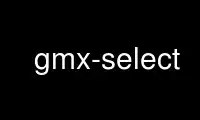
This is the command gmx-select that can be run in the OnWorks free hosting provider using one of our multiple free online workstations such as Ubuntu Online, Fedora Online, Windows online emulator or MAC OS online emulator
PROGRAM:
NAME
gmx-select - Print general information about selections
SYNOPSIS
gmx select [-f [<.xtc/.trr/...>]] [-s [<.tpr/.gro/...>]] [-n [<.ndx>]]
[-os [<.xvg>]] [-oc [<.xvg>]] [-oi [<.dat>]]
[-on [<.ndx>]] [-om [<.xvg>]] [-of [<.xvg>]]
[-ofpdb [<.pdb>]] [-olt [<.xvg>]] [-b <time>] [-e <time>]
[-dt <time>] [-tu <enum>] [-xvg <enum>] [-[no]rmpbc]
[-[no]pbc] [-sf <file>] [-selrpos <enum>]
[-seltype <enum>] [-select <selection>] [-[no]norm]
[-[no]cfnorm] [-resnr <enum>] [-pdbatoms <enum>]
[-[no]cumlt]
DESCRIPTION
gmx select writes out basic data about dynamic selections. It can be used for some simple
analyses, or the output can be combined with output from other programs and/or external
analysis programs to calculate more complex things. For detailed help on the selection
syntax, please use gmx help selections.
Any combination of the output options is possible, but note that -om only operates on the
first selection. Also note that if you provide no output options, no output is produced.
With -os, calculates the number of positions in each selection for each frame. With -norm,
the output is between 0 and 1 and describes the fraction from the maximum number of
positions (e.g., for selection 'resname RA and x < 5' the maximum number of positions is
the number of atoms in RA residues). With -cfnorm, the output is divided by the fraction
covered by the selection. -norm and -cfnorm can be specified independently of one
another.
With -oc, the fraction covered by each selection is written out as a function of time.
With -oi, the selected atoms/residues/molecules are written out as a function of time. In
the output, the first column contains the frame time, the second contains the number of
positions, followed by the atom/residue/molecule numbers. If more than one selection is
specified, the size of the second group immediately follows the last number of the first
group and so on.
With -on, the selected atoms are written as a index file compatible with make_ndx and the
analyzing tools. Each selection is written as a selection group and for dynamic selections
a group is written for each frame.
For residue numbers, the output of -oi can be controlled with -resnr: number (default)
prints the residue numbers as they appear in the input file, while index prints unique
numbers assigned to the residues in the order they appear in the input file, starting with
1. The former is more intuitive, but if the input contains multiple residues with the same
number, the output can be less useful.
With -om, a mask is printed for the first selection as a function of time. Each line in
the output corresponds to one frame, and contains either 0/1 for each
atom/residue/molecule possibly selected. 1 stands for the atom/residue/molecule being
selected for the current frame, 0 for not selected.
With -of, the occupancy fraction of each position (i.e., the fraction of frames where the
position is selected) is printed.
With -ofpdb, a PDB file is written out where the occupancy column is filled with the
occupancy fraction of each atom in the selection. The coordinates in the PDB file will be
those from the input topology. -pdbatoms can be used to control which atoms appear in the
output PDB file: with all all atoms are present, with maxsel all atoms possibly selected
by the selection are present, and with selected only atoms that are selected at least in
one frame are present.
With -olt, a histogram is produced that shows the number of selected positions as a
function of the time the position was continuously selected. -cumlt can be used to control
whether subintervals of longer intervals are included in the histogram.
-om, -of, and -olt only make sense with dynamic selections.
OPTIONS
Options to specify input files:
-f [<.xtc/.trr/...>] (traj.xtc) (Optional)
Input trajectory or single configuration: xtc trr cpt gro g96 pdb tng
-s [<.tpr/.gro/...>] (topol.tpr) (Optional)
Input structure: tpr gro g96 pdb brk ent
-n [<.ndx>] (index.ndx) (Optional)
Extra index groups
Options to specify output files:
-os [<.xvg>] (size.xvg) (Optional)
Number of positions in each selection
-oc [<.xvg>] (cfrac.xvg) (Optional)
Covered fraction for each selection
-oi [<.dat>] (index.dat) (Optional)
Indices selected by each selection
-on [<.ndx>] (index.ndx) (Optional)
Index file from the selection
-om [<.xvg>] (mask.xvg) (Optional)
Mask for selected positions
-of [<.xvg>] (occupancy.xvg) (Optional)
Occupied fraction for selected positions
-ofpdb [<.pdb>] (occupancy.pdb) (Optional)
PDB file with occupied fraction for selected positions
-olt [<.xvg>] (lifetime.xvg) (Optional)
Lifetime histogram
Other options:
-b <time> (0)
First frame (ps) to read from trajectory
-e <time> (0)
Last frame (ps) to read from trajectory
-dt <time> (0)
Only use frame if t MOD dt == first time (ps)
-tu <enum> (ps)
Unit for time values: fs, ps, ns, us, ms, s
-xvg <enum> (xmgrace)
Plot formatting: none, xmgrace, xmgr
-[no]rmpbc (yes)
Make molecules whole for each frame
-[no]pbc (yes)
Use periodic boundary conditions for distance calculation
-sf <file>
Provide selections from files
-selrpos <enum> (atom)
Selection reference positions: atom, res_com, res_cog, mol_com, mol_cog,
whole_res_com, whole_res_cog, whole_mol_com, whole_mol_cog, part_res_com,
part_res_cog, part_mol_com, part_mol_cog, dyn_res_com, dyn_res_cog, dyn_mol_com,
dyn_mol_cog
-seltype <enum> (atom)
Default selection output positions: atom, res_com, res_cog, mol_com, mol_cog,
whole_res_com, whole_res_cog, whole_mol_com, whole_mol_cog, part_res_com,
part_res_cog, part_mol_com, part_mol_cog, dyn_res_com, dyn_res_cog, dyn_mol_com,
dyn_mol_cog
-select <selection>
Selections to analyze
-[no]norm (no)
Normalize by total number of positions with -os
-[no]cfnorm (no)
Normalize by covered fraction with -os
-resnr <enum> (number)
Residue number output type with -oi and -on: number, index
-pdbatoms <enum> (all)
Atoms to write with -ofpdb: all, maxsel, selected
-[no]cumlt (yes)
Cumulate subintervals of longer intervals in -olt
Use gmx-select online using onworks.net services
